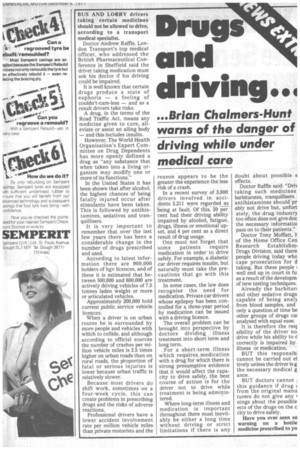Drugs and
Page 29

If you've noticed an error in this article please click here to report it so we can fix it.
...Brian Chalmers-Hunt warns of the danger of driving while under medical care
BUS AND LORRY drivers taking certain medicines should not be allowed to drive, according to a transport medical specialist.
Doctor Andrew Raffle, London Transport's top medical officer, who addressed the British Pharmaceutical Conference in Sheffield said the driver taking medication must ask his doctor if his driving could be impaired.
It is well known that certain drugs produce a state of euphoria — a feeling of couldn't-care-less — and as a result drivers take risks.
A drug, in the terms of the Road Traffic Act, means any medicine given to cure, alleviate or assist an ailing body — and this includes insulin.
However, The World Health Organisation's Expert Committee on Drug Dependents has more openly defined a drug as "any substance that when taken into a living organism may modify one or more of its functions."
In the United States it has been shown that after alcohol, the highest chances of being fatally injured occur after stimulants have been taken. This is followed by antihistamines, sedatives and tranquillisers.
It is very important to remember that over the last few years there has been a considerable change in the number of drugs prescribed and used.
According to latest information there are 900,000 holders of hgv licences, and of these it is estimated that between 500,000 and 600,000 are actively driving vehicles of 7.5 tonnes laden weight or more or articulated vehicles.
Approximately 200,000 hold current public service vehicle licences.
When a driver is on urban routes he is surrounded by more people and vehicles with which to collide, and although according to official sources the number of crashes per million vehicle miles is 2.5 times higher on urban roads than on rural roads, the -Proportion of fatal or serious injuries is lower because urban traffic is relatively slower.
Because most drivers do shift work, sometimes on a four-week cycle, this can create problems in prescribing drugs and the risks of adverse reactions.
Professional drivers have a lower accident involvement rate per million vehicle miles than private motorists and the reason appears to be the greater the experience the less risk of a crash.
In a recent survey of 3,800 drivers involved in accidents 2,211 were regarded as being at fault. Of this, 2-0 per cent had their driving ability impaired by alcohol, fatigue, drugs, illness or emotional upset, and 4 per cent as a direct result of drug usage.
One must not forget that some patients require medication in order to drive safely. For example, a diabetic car driver requires insulin, but naturally must take the precautions that go with this treatment.
In some cases, the law does recognise the need for medication. Private car drivers whose epilepsy has been controlled for a three-year period by medication can be issued with a driving licence.
The overall problem can be brought into perspective by doctors dividing illness treatment into short term and long term.
For a short-term illness which requires medication with a drug for which there is strong presumptive evidence that it would affect the capacity to drive safely, the best course of action is for the driver not to drive while treatment is being administered.
Where long-term illness and medication is important throughout there must inevitably be either a long time without driving or strict limitations if there is any doubt about possible s effects.
Doctor Raffle said: "Drib taking such medicines barbiturates, tranquillisers antihistamines should pr ably not drive but, unfort ately, the drug industry too often does not give doc the necessary informatioi pass on to their patients."
Doctor Tony Moffatt, h of the Home Office Cen Research Establishmf Drugs Division, said there people driving today who cape prosecution for d taking. But these people well end up in court in fu as a result of the developm, of new testing techniques.
Already the barbitun and other sedative drugs capable of being analy from blood samples, and only a question, of time be other groups of drugs cal analysed with equal ease.
It is therefore the resi sibility of the driver no drive while his ability to d correctly is impaired by illness or medication.
BUT this responsibi cannot be carried out ef tively unless the driver is g the necessary medical g ance.
BUT doctors cannot , this guidance if drug ( from the original manu turers do not give any nings about the possible ects of the drugs on the c city to drive safely.
Have you ever seen su warning on a bottle medicine prescribed to yo




































































































